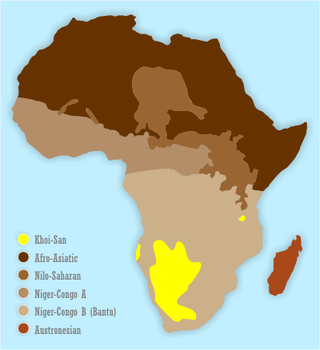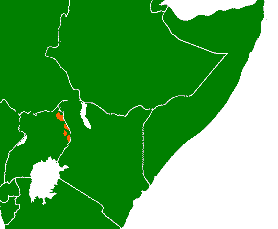Related Research Articles

The Cushitic languages are a branch of the Afroasiatic language family. They are spoken primarily in the Horn of Africa, with minorities speaking Cushitic languages to the north in Egypt and Sudan, and to the south in Kenya and Tanzania. As of 2012, the Cushitic languages with over one million speakers were Oromo, Somali, Beja, Afar, Hadiyya, Kambaata, and Sidama.

The Khoisan languages are a number of African languages once classified together, originally by Joseph Greenberg. Khoisan is defined as those languages that have click consonants and do not belong to other African language families. For much of the 20th century, they were thought to be genealogically related to each other, but this is no longer accepted. They are now held to comprise three distinct language families and two language isolates.

The Nilo-Saharan languages are a proposed family of African languages spoken by somewhere around 70 million speakers, mainly in the upper parts of the Chari and Nile rivers, including historic Nubia, north of where the two tributaries of the Nile meet. The languages extend through 17 nations in the northern half of Africa: from Algeria to Benin in the west; from Libya to the Democratic Republic of the Congo in the centre; and from Egypt to Tanzania in the east.
The Nilotic peoples are people indigenous to the Nile Valley who speak Nilotic languages. They inhabit South Sudan, Sudan, Ethiopia, Uganda, Kenya, the eastern border area of Democratic Republic of the Congo, Rwanda, Burundi and Tanzania. Among these are the Burun-speaking peoples, Teso people also known as Iteso or people of Teso, Karo peoples, Luo peoples, Ateker peoples, Kalenjin peoples, Karamojong people also known as the Karamojong or Karimojong, Datooga, Dinka, Nuer, Atwot, Lotuko, and the Maa-speaking peoples.

The Nilotic languages are a group of related languages spoken across a wide area between South Sudan and Tanzania by the Nilotic peoples.
Dorobo is a derogatory umbrella term for several unrelated hunter-gatherer groups of Kenya and Tanzania. They comprised client groups to the Maasai and did not practice cattle pastoralism.
The Elgon languages are languages of the Southern Nilotic Kalenjin family spoken in the Mount Elgon area in western Kenya and eastern Uganda. According to the Ethnologue, there are two main Elgon languages: Kupsabiny and Sabaot. Sabaot is a common name assumed by various related peoples, including the Kony, Pok, and Bong'om, whose respective languages are considered separate languages by Rottland (1982).
The Kalenjin languages are a family of a dozen Southern Nilotic languages spoken in Kenya, eastern Uganda and northern Tanzania. The term Kalenjin comes from an expression meaning 'I say ' or 'I have told you'. Kalenjin in this broad linguistic sense should not be confused with Kalenjin as a term for the common identity the Nandi-speaking peoples of Kenya assumed halfway through the twentieth century; see Kalenjin people and Kalenjin language.
Pökoot is a language spoken in western Kenya and eastern Uganda by the Pokot people. Pökoot is classified to the northern branch of the Kalenjin languages found in Kenya, Uganda, and Tanzania. The Pökoot are usually called "Kimukon" by the other Kalenjin peoples. A 1994 figure of SIL puts the total number of speakers at 264,000, while the only slightly more recent Schladt (1997:40) gives the more conservative estimate of 150,000 people, presumably based on the figures found in Rottland (1982:26) who puts the number at slightly more than 115,000.
Ogiek is a Southern Nilotic language of the Kalenjin family spoken or once spoken by the Ogiek peoples, scattered groups of hunter-gatherers in Southern Kenya and Northern Tanzania. Most Ogiek speakers have assimilated to cultures of surrounding peoples: the Akie in northern Tanzania now speak Maasai and the Ogiek of Kinare, Kenya now speak Gikuyu. Ndorobo is a term considered derogatory, occasionally used to refer to various groups of hunter-gatherers in this area, including the Ogiek.

The Kuliak languages, also called the Rub languages, are a group of languages spoken by small relict communities in the mountainous Karamoja region of northeastern Uganda.
The Elgeyo language, or Kalenjin proper, are a dialect cluster of the Kalenjin branch of the Nilotic language family.

In Uganda the most spoken language in the capital city is Luganda, followed by English, as all schools in Uganda use it in their studies due to the introduction of English during the colonial period. English is also the language of business and judicial matters. Most spoken after Luganda and English is Swahili. This language is more common in neighbouring Kenya and Tanzania. Swahili is taught in schools as an optional additional language and it is mostly spoken by the Ugandan army. In 2005, there were talks to include Swahili as the second official language as it was seen as neutral, however this is still not ratified by the government. Swahili is used among some communities bordering South Sudan and Kenya.
The Maa languages are a group of closely related Eastern Nilotic languages spoken in parts of Kenya and Tanzania by more than a million speakers. They are subdivided into North and South Maa. The Maa languages are related to the Lotuko languages spoken in South Sudan.
Sonjo, or Temi, is a Bantu language spoken in northern Tanzania, 30–40 miles (48–64 km) west of Lake Natron. Ethnolinguistically, it is a displaced member of Guthrie’s E50 group, most other members of which are found in Central Kenya. Within that group, it is most closely related to Gikuyu. The Sonjo people number about 30,000 ; many of them are bilingual in Swahili, the local language of education. Sonjo is largely undescribed.

The Datooga,, are a Nilotic ethnic people group from Karatu District of Arusha Region and historically in areas of south west Manyara Region, and northern Singida Region of Tanzania. In 2000 the Datooga population was estimated to number 87,978.
Datooga is a Nilotic language or dialect cluster of the Southern Nilotic group. It is spoken by the Datooga people of the Great Rift Valley of Tanzania. The Sukuma name Taturu is also sometimes used in English; the Swahili name Mang'ati comes from Maasai, where it means "enemy". However, it is not considered offensive to the Datooga, as there is a degree of pride in being the historic enemy of the Maasai, and Mang'ati has become the standard name for the group in Swahili. In addition, numerous tribal and dialectal names may be found for the people or language as a whole.
Keiyo is a Kalenjin language spoken in western Kenya, in the southern part of the district of Elgeyo-Marakwet.
The Kalenjin people are an ethnolinguistic group indigenous to East Africa, with a presence, as dated by archaeology and linguistics, that goes back many centuries. Their history is therefore deeply interwoven with those of their neighboring communities as well as with the histories of Kenya, Uganda, Tanzania, South Sudan, and Ethiopia.
Franz Rottland was a German linguist and Africanist.
References
- ↑ Rottland, Franz (1982) Die Südnilotischen Sprachen: Beschreibung, Vergleichung und Rekonstruktion (Kölner Beiträge zur Afrikanistik vol. 7). Berlin: Dietrich Reimer.
- ↑ Rottland, Franz. 1979. The reconstruction of proto-Kalenjin. (Papers from the Inst. of African Studies (IAS), 128.) Nairobi: Institute of African Studies, University of Nairobi.
- ↑ Güldemann, Tom (2018). "Historical linguistics and genealogical language classification in Africa". In Güldemann, Tom (ed.). The Languages and Linguistics of Africa. The World of Linguistics series. Vol. 11. Berlin: De Gruyter Mouton. pp. 58–444. doi:10.1515/9783110421668-002. ISBN 978-3-11-042606-9.
- ↑ Heine, Bernd, Franz Rottland & Rainer Voßen. 1979. Proto-Baz: Some aspects of early Nilotic-Cushitic contacts. Sprache und Geschichte in Afrika 1. 75‒92.